The Côtes de Bordeaux (Côtes  means Coasts in French) are located in the East, on steep slopes of hills and valleys created by the Garonne and Dordogne Rivers that flow through the area.
means Coasts in French) are located in the East, on steep slopes of hills and valleys created by the Garonne and Dordogne Rivers that flow through the area.
In fact on the Côtes land, water is everywhere: rivers, estuary, ocean, fresh and salty waters. The bores (mascarets in French) allow the ocean to forge inland 160 km from the Atlantic coast during the autumn equinox tides and the Rivers Gironde and Garonne meet at the Bec d’Ambes, a spit of land which has grown with the passing of the centuries due to deposits of river silt.
After the confluence, the two rivers entwine into a stream sometimes 15 km wide.
It’s such a large estuary that it’s been described it as the “European Mississipi” and the vineyards are limited to the slopes that tower above the Garonne for 100 km from north to south with excellent exposure to the sun.
The weather is very sunny here and the vines generally face south or south west but the large river moderates the stifling summer heat. Due to the slopes tending the vines is more difficult and the wines can be complex and concentrated.
Recently the appellations within the Côtes banded together to create the  Côtes de Bordeaux encompassing Côtes de Blaye, Premières Côtes de Bordeaux et Cadillac, Côtes de Castillon and Côtes de Francs. The AOC Côtes de Bourg opted to stay out.
Côtes de Bordeaux encompassing Côtes de Blaye, Premières Côtes de Bordeaux et Cadillac, Côtes de Castillon and Côtes de Francs. The AOC Côtes de Bourg opted to stay out.
The reasoning behind this consolidatory move is to increase the understanding and visibility of the wines from this region. The objective is to achieve consistency and also to acquire renown creating a solid basis for the wine trade.
The Côtes de Bordeaux represent around 10% of the total Bordeaux production but they have a share of only 14% of the total Bordeaux export: 86% of the wines are sold in France and 13% are exported.
Certain Côtes AOCs produce a significant amount of white wines and sweet wines, thanks to a specific micro climate that favours 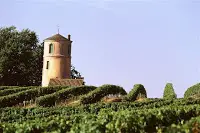 the over-ripening of the grapes, as well as reds.
the over-ripening of the grapes, as well as reds.
The Côtes de Bordeaux cover 13,5000 hectares, 40 000 acres on 91 villages. Côtes de Blaye (named for the City of Blaye) is located on the right bank of the Gironde, 50 km from Bordeaux.
The area is characterized by clayish and gravelly knolls where Merlot, Cabernet Franc and Cabernet Sauvignon are planted for the red wines whereas Sauvignon is planted for the white ones.
The Premières Côtes de Bordeaux et Cadillac is spread in a thin 60 km long, 5 km large strip of vineyard, from the north of Bordeaux to Langon, on the chalky cliff hugging every contour of the right bank of the Garonne.
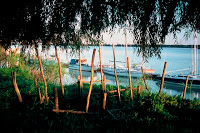 The Côtes de de Castillon are limited to the west by the Saint Emilion hills, to the south by the Dordogne river and to the east by the Dordogne department and the Côtes de Francs is located between the Isle valleys and the Dordogne.
The Côtes de de Castillon are limited to the west by the Saint Emilion hills, to the south by the Dordogne river and to the east by the Dordogne department and the Côtes de Francs is located between the Isle valleys and the Dordogne.
Blaye – Côtes de Bordeaux vine varieties are 70 % Merlot, 20% Cabernet Sauvignon, 10 % Cabernet Franc and Malbec for the reds and Sauvignon Blanc, Muscadelle and Semillon for the whites.
The red wines offer a superb colour and are very fruity and supple and the whites have broom and citrus fruits aromas that are typical of the Sauvignon Blanc grape.
Castillon – Côtes de Bordeaux red vine varieties are 70 % Merlot, 20% Cabernet Franc and 10 % Cabernet Sauvignon. The wines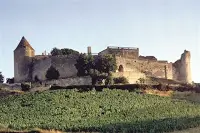 have a dark ruby colour and their bouquet ranges from prune, leather, game, undergrowth to small ripe red berries.
have a dark ruby colour and their bouquet ranges from prune, leather, game, undergrowth to small ripe red berries.
These are fruity and full bodied wines with a big capacity for ageing. For more information on this AOC check out my Blog Côtes de Castillon, Alouettes sans Tête and Wine.
Cadillac – Côtes de Bordeaux red vine varieties are 55 % Merlot, 25 % Cabernet Sauvignon, 15 % Cabernet Franc and 5 % Malbec. The whites are 70 % Sémillon, 17 % Sauvignon and 13 % Muscadelle.
 The red wines are nearly black with delicate aromas, great suppleness and superb structure. They can be drunk young but it is worth waiting ( 4/10 years, even more sometimes). For more information on the sweet white wines of Cadillac see my Blog Sweet Bordeaux – Cadillac.
The red wines are nearly black with delicate aromas, great suppleness and superb structure. They can be drunk young but it is worth waiting ( 4/10 years, even more sometimes). For more information on the sweet white wines of Cadillac see my Blog Sweet Bordeaux – Cadillac.
Francs – Côtes de Bordeaux red vine varieties are 50 % Merlot, 25 % Cabernet Franc, 25 % Cabernet Sauvignon and the whites are 60 % Sémillon, 20 % Muscadelle and 20 % Sauvignon. The reds are full coloured, robust, fleshy wines and the whites (aged in oak barrels) have flavours of honey and pineapple to citrus fruit.
There is a classic French dish which pairs well with both red and white wine that is often described as the ultimate French comfort food: Blanquette de Veau.
The term ‘blanquette’ comes from the 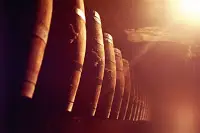 French word for “white” (blanc), being a ragout (stew) of unbrowned meat with a white sauce. Other meats besides veal may be prepared ‘en blanquette’ (the traditional ‘white meats’ – pork, rabbit, chicken – as well as lamb) but blanquette de veau is the most famous example of this method.
French word for “white” (blanc), being a ragout (stew) of unbrowned meat with a white sauce. Other meats besides veal may be prepared ‘en blanquette’ (the traditional ‘white meats’ – pork, rabbit, chicken – as well as lamb) but blanquette de veau is the most famous example of this method.
In a typical recipe, pieces of veal meat (shoulder, breast) and aromatic vegetables (onion, celery, carrot etc) are simmered at length in water or stock.
The vegetables may then be discarded and the cooking liquid is thickened and enriched with flour, butter, cream and egg yolks. Mushrooms, rice, pasta and potatoes are common accompaniments to this dish, which is served hot.
Blanquette de Veau
3 lbs veal (or the white meat of your choice)
1 onion
1 clove
1 carrot
18 shallots or pearl onions (peeled)
½ lb mushrooms
2 sprigs thyme
bunch of parsley
1 celery stalk
1 bay leaf
2 egg yolks
½ cup whipping cream
1 lemon juice
butter
salt
6 cups water
Cut the veal into 2-inch c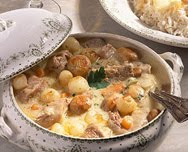 ubes. Stick the onion with a clove. Tie together the celery, thyme, bay and parsley. Melt 3 tablespoons of butter with oil in a casserole. Add the veal. Add the carrots, onion, herbs and salt. Add water to cover the meat.
ubes. Stick the onion with a clove. Tie together the celery, thyme, bay and parsley. Melt 3 tablespoons of butter with oil in a casserole. Add the veal. Add the carrots, onion, herbs and salt. Add water to cover the meat.
Cook over high heat and bring to a boil. Reduce the heat, cover and simmer for 45 minutes. Peel the white pearl onions. Clean the mushrooms and cut them into quarters. Melt 3 tablespoons of butter in a pan. Add the mushrooms, salt and pepper. Sauté until lightly browned.
Remove the mushrooms. Add 2 tablespoons of butter in the pan, add the pearl onions and sauté for 1 or 2 minutes. Return the mushrooms to the pan and keep warm. Combine the egg yolks with the cream and half of the lemon juice in a bowl. Remove the meat, the mushrooms and onions and place them in a serving dish.
Pour the cream with the egg-yolk in the meat juice in the casserole. Cook over very low heat for 10 minutes. Do not let the sauce boil. Add the lemon juice, salt and pepper if needed. Pour the sauce over the meat in the dish.
The wines I would recommend to go with this dish are the w hite Château Pape Clement (ranging from £50 – £100 depending on the vintage).
hite Château Pape Clement (ranging from £50 – £100 depending on the vintage).
Pape Clement is the oldest wine estate in Bordeaux and the white wines are elegant and have a purity of style. They are full bodied with undertones of honey, apricots and melons with a refreshing vibrancy.
£6.60) is another super choice as its a refreshing and exceptional wine. Golden in colour this truly is beautifully presented with loads of fruity aromas and intense fruit and honey in the mouth.
It is full of elegance and will be thoroughly enjoyed and appreciated by white wine lovers.
As for a red wine I would select Chateau Marqui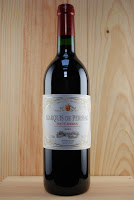 s de Perissac (£5.62) with its nice bright colour and good fruity aroma.
s de Perissac (£5.62) with its nice bright colour and good fruity aroma.
It has soft tannins which give a soft fruity release in the mouth with a hint of cherries and blackberries. Being a medium weighted wine it is perfect drinking with meals creamy Stroganoffs, Fricassees and Blanquettes..
It also captures and enhances the flavours of many Vegetarian delicacies, which contain protein based items such as Nuts, Lentils and Beans.

